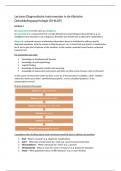Lectures Diagnostische Instrumenten in de Klinische
Ontwikkelingspsychologie (DI-KLOP)
Lecture 1
An assessment is not the same as a diagnosis.
An assessment is a measurement of a certain behavioral or psychological characteristic (e.g. an
intelligence test). But that is not a diagnosis, therefore you should look at alternative explanations.
Diagnosis: systematic process of obtaining information about an individual to address specific
diagnostic questions, with the reason to help the person. So, it should not only lead to a classification,
but it has to give the full picture of the situation, as the context, potential causal factors, proposed
treatment etc.
For assessment you need:
Knowledge of developmental theories
Knowledge of psychopathology
Logical thinking
knowledge of diagnostic models and reasoning
knowledge of assessment instruments and their use (this course focuses most on this part)
In this course we focus then when we have a case on, if the test done is suitable?, valid?, reliable?,
where the norms up to date?, administered properly?, scores calculated properly?, is the
interpretation correct?
Process learned in this course:
5 questions when thinking about what instrument would be best to address my question:
1. Doel - What is my goal? (e.g. diagnostic classification)
2. Soort – What type of instrument do I need (e.g. semi-structured interview)
3. Informatiebron – Which informant do I need? (e.g. a parent)
4. Meetpretentie - What an area do I want to measure? (e.g. depressive disorder)
5. Groep – What population does a child belong to? (e.g. 11 year-old boy)
,For the goal (and hypothesis etc.) it is important to look at the Diagnostische cyclus:
Screening: initial indication of risk for a problem or disorder (gives us a probability of how serious the
problem is and if it should be classified and should guide if a child has to be referred for a proper
diagnostic)
There are different kinds of screening;
Universal / mass screening: allows to identify individuals at risk of a problem across the
general population (maybe it can be made clear that some children need further
investigation)
Can be by school, healthcare, social worker etc.
Targeted screening: can be used to assess a risk in selected individuals and refer for further
diagnosis or intervention (e.g. for a specific child in class, so it can get the help it needs)
Clinical screening: aimed at informing the (psycho)diagnostic process
All the screening instruments are common in use, but their psychometric quality is often limited
For the raise of good screening practices you can use:
Multiple informants
Two-staged screening (e.g. a questionnaire, and who scores above a threshold get another
test/questionnaire)
Uses of screening on different places in the cycle:
1. What are (potential) problems?
2. For the intake-fase, to gain more information from more informants
3. What is the severity of the problem? – severity assessment (ernsttaxatie) (you need to take
into account more, e.g. more contexts, times etc. for a real severity assessment, but it can
guide you)
A score from a screening doesn’t say everything, you still are a diagnostician, so your opinion matters
Never make a diagnosis using only a screening. They can even be harmful, due to the confirmation
bias
Problem analysis: a definite formulation of a problem or problems, usually grouped in the problem
clusters (wider than just finding problems)
testing a descriptive hypothesis (onderkennende hypothese)
can be based on a (psychiatric) classification but also other sources (e.g. ASEBA, CAP-J)
, Classification: usually involves the use of a (semi-structured) interview and observation, and other
measures, and the integration of different sources of information
(e.g. school reports, medical reports)
Assessment =//= classification =//= diagnosis
Classification is a label showing some kind of a syndrome that is written in the diagnostic manual. But
a diagnosis is more complex, also describing underlying causes, context, proposed recommendations
and treatment
Explanatory analysis (verklaringsanalyse): allows to find causal and maintaining factors for the
development of the problem.
It involves all kinds of measures, including performance tests, systematic observation of behavior, and
questionnaires etc.
Crucial to make a comprehensive diagnosis and plan for intervention – the type of cause found in the
explanatory diagnosis is important, because it determines also which type of treatment (e.g. does a
child have hearing problems or a low intelligence (assessment of intervention))
Indicative analysis: describing strengths and weaknesses of the child in order to form some kind of
advice (not an intervention yet)
functional assessment is more detailed the strengths and weaknesses is a specific environment –
after this is intervention evaluation
Intervention evaluation:
Monitoring the process (is the treatment efficient?
Was an intervention effective?
All kinds of instrument can be used, but have to be sensitive to change
Standardized instrument provide standard conditions for administration of the test (instruction for
the diagnostician and client en instruction for tests)
also provide a way (objective method) to calculate and what to do with it, so gives also a norm /
criterion to interpret the results (what we can do with the results)
(at best they also know their psychometric qualities, reliability, validity etc.)
Structured interviews have specific answers / maybe boxes to tic, but we don’t know what to do with
the results, no norms on how to interpret.
(standardized does not have to be structured)
What kind of result is the instrument providing:





